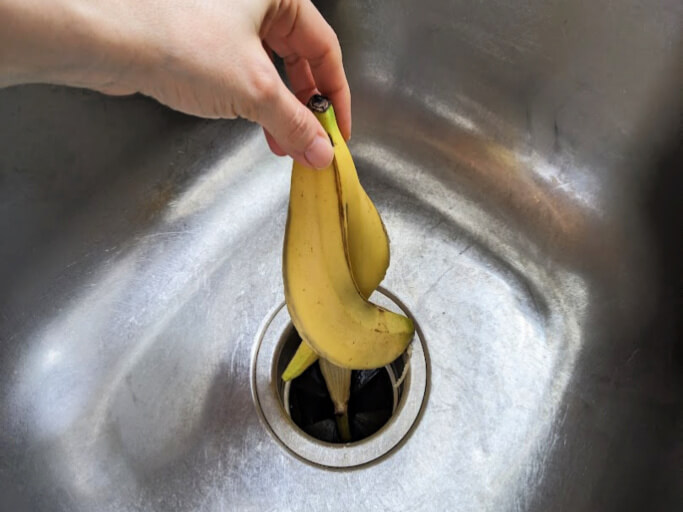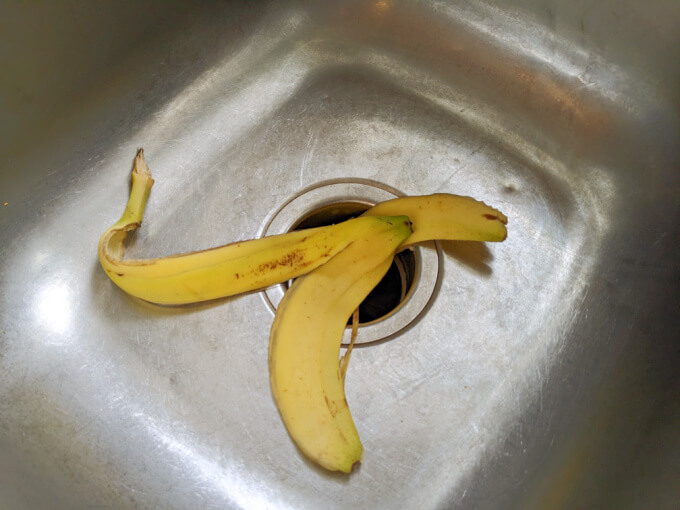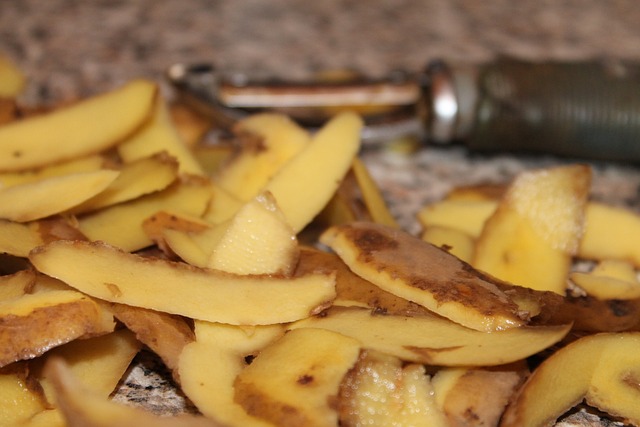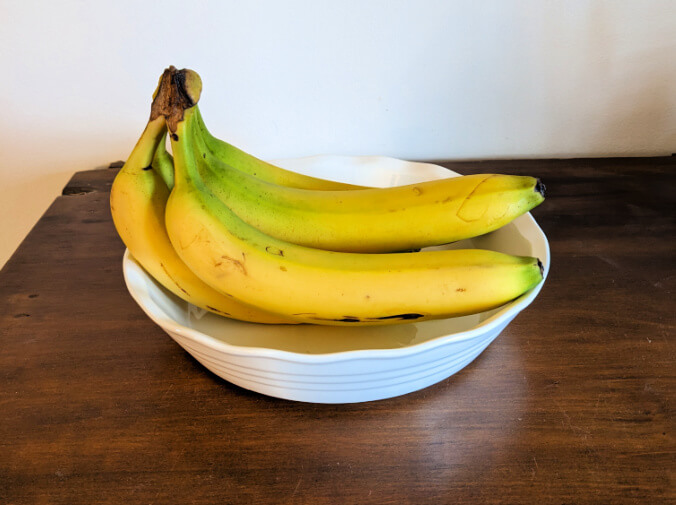Can You Put Banana Peels in the Garbage Disposal?
We often take our modern conveniences for granted. And while our kitchen appliances may not get much attention, they really do make our lives much easier. One very useful but sometimes misunderstood kitchen appliance is the garbage disposal. But can you put banana peels in the garbage disposal?
Keep reading to find out, as well as alternative ways to use banana peels!
Affiliate links included below, which means I may make a small commission at no extra cost to you. Read my disclosure here.
What to do with all the Food Waste?
People create waste. A lot of waste. The average American creates a little less than 5 pounds of trash every single day. The average family produces about 18 pounds of waste per day!
While some of this waste includes non-food items such as paper and plastic, large amounts of food waste are also produced each day.
What are we supposed to do with all the left over food waste? You know, things like coffee grounds, fruit pits, carrot peels, and egg shells.
Many people just throw everything away in the trash can. Others prefer to use their garbage disposal to grind up as many food scraps as possible. But this may not be a good idea over the long run.
Can you Put Banana Peels in the Garbage Disposal?
While researching whether it’s safe to put banana peels in the garbage disposal, I came across a variety of opinions.
Some people insist that yes, it’s fine to put a banana skin down the disposal.
Others take the opposite view and say no, never put any fruit peels–including those from bananas–into your disposal.
While I wish I could give you a straightforward, one-size-fits-all answer, it just isn’t that simple!
However, there are guidelines to help you decide on whether banana peels should go in your garbage disposal.
How Horsepower Determines Chopping Ability
One of the most important things to consider is the power of your garbage disposal.
Disposal units for home use range in power from 1/3 hp (horsepower) up to 1 hp.
As you might have guessed, the higher the horsepower, the stronger the chopping ability.
If you have a heavy-duty, 3/4 hp or even 1 hp disposal, you should be safer grinding up denser, more fibrous items like banana peels.
On the other hand, the garbage disposal under my kitchen sink is a smaller 1/3 hp unit. Because of this, I’m very selective about what I send down the drain.
TOP CHOICE GARBAGE DISPOSAL
SEE ON AMAZON*Compact and powerful with quiet motor
Due to its smaller, less powerful motor, I don’t put banana peels down my disposal unit.
The risk of clogs from the high fiber content is too high with lower horsepower units. Having to call for expert plumbing service can be expensive!
So to answer the question, “can banana peels go in a garbage disposal?” they can if you have a more powerful unit. But it’s not recommended for low-power disposals such as a 1/3 hp one.
When disposing of banana peels, there may be better options than grinding, particularly if you have a vegetable or flower garden. (See the section down below on composting!)
Less is Better With Your Disposal
If you do decide to put banana skins into your disposal, first cut them with kitchen shears into smaller pieces before grinding.
Disposing of only small amounts of food debris and fibrous foods like vegetable peelings makes it much less likely to clog.
Sending large volumes of waste into your unit can be a really bad idea that clogs up your garbage disposal pipe.
A better option is to make sure all of the peels, vegetable skins, or whatever food waste you’re grinding are fully ground up before putting more waste down the unit.
The best option is to take your time and slowly drop small quantities of food into the disposal.
Stuffing too much waste at one time into the food waste disposer can cause overheating and potentially damage the motor.
What Foods are Safe to Put in the Garbage Disposal?
Kitchen garbage disposals are designed to safely and efficiently chop up leftover food waste. This is a great way to get rid of waste without having to throw everything into the trash can.
But not all foods are safe to run through your garbage disposal.
Disposals have no problems with soft, cooked foods. Things like leftover canned pet food, cooked eggs, and soft, boneless meats are safe to run through the garbage disposal .
Many kinds of vegetable and fruit matter are also totally fine to get rid of in this way.
Garbage disposal blades can easily chop up soft plant materials like cooked vegetable and fruit matter. They can also handle some types of uncooked fruit and vegetable parts.
But things do get a little tricky when you start talking about uncooked fruit and vegetable rinds and skins.
Some experts say it’s okay to put small pieces of citrus rinds like lemon peels and orange peels into your garbage disposal system; others caution against this.
What Foods are Unsafe to Put in the Garbage Disposal
There’s some difference of opinion about which foods are unsafe to put in your garbage disposal.
Some plumbing experts say it’s fine to put small bones in the disposal. Others say chicken bones and other animal bones are too hard and can dull the disposal blades.
Just about everyone agrees that uncooked potato peels shouldn’t go down the disposal. These potato skins can actually turn into a thick paste that can clog drain pipes.
Corn husks are also a no-no for your disposal. These tough husks contain fibrous materials and silky threads that can cause a disposal disaster.
Outer and inner onion skins are also not recommended to go down into the garbage disposal unit. This is because the thin membrane of onion peels can squeeze through the blades and cause havoc with your plumbing system.
Fibrous fruits like pineapple tops should not be sent down the drain for grinding. The same applies to a watermelon rind. (Watermelon flesh is soft and totally safe to grind.)
You should also avoid putting fibrous vegetables like celery, raw pumpkins, and other squash in the disposal.
A few sources suggest that putting cherry pits or peach pits into a disposal is fine. But most others insist that these very hard items put too much strain on your disposal.
It’s inadvisable to put nuts and peanut butter into your disposal. These can gum up your pipes and cause unwanted plumbing issues.
Also avoid apple cores, pumpkin seeds and watermelon seeds. These seeds can escape the blades of the garbage disposal, causing clogs and a slow drain.
Oats, pasta and bread can also swell and potentially harm your disposal system.
Large quantities of oils and fats are also not recommended for drains.
If there is any fat put into the disposal, be sure to run cold water. This will help the fat to congeal and make it easier to chop and pass on down the pipes. Hot water can potentially dislodge fats and result in clogging.
What Else You Can do With Banana Peels
If you’re like me and have a lower horsepower garbage disposal, you don’t want to grind up your leftover banana peels because this could damage the disposal and possibly cause plumbing clogs.
In that case, you’ll be interested in learning an alternative method for what to do with them.
The easy way is to just throw them in the trash. However, this is bad advice as old peels can start rotting and attract flies and gnats to your home and garbage can.
Not only that, all those peels and other food scraps end up decaying in huge mounds in a landfill.
There are some better ways to use your banana peels!
Compost Your Banana Peels
If you already have a garden, you may be familiar with composting.
Composting is simply the process of turning waste products like old leaves, grass clippings, and food waste into food for your soil.
Fruit and vegetable peels make some of the very best material for composting!.
One very good way of using banana peels is as green material for composting.
Banana peels contain carbon and nitrogen along with minerals like potassium. These are all great additions to a compost pile!
To compost your peels, simply put them in a covered container such as a one-gallon pail.
You can also find compost bins that use removable compostable bags for ease of use and odor control.
TOP CHOICE COMPOST BIN
SEE ON AMAZON*Large capacity, uses compostable bags for odor control and easy clean up
Are Banana Peels Edible?
It may surprise you to learn that you can actually eat banana peels!
Peels are a good source of fiber and contain natural substance that may help fight inflammation.
You may wish to buy organic bananas to help minimize exposure to pesticide residue.
To eat a banana peel, make sure it’s fully ripe, then remove the inedible stem.
You can mash up a whole ripe banana–including the peel but minus the stem–to use in recipes such as banana muffins and bread.
Another option is to use leftover banana peels to make banana peel bacon!
Find More Kitchen Tips:
- Can You Put Coffee in the Fridge?
- 15 Surprising Uses for Baking Soda
- 9 Must-Have Real Food Kitchen Tools
- 12 Creative and Smart Kitchen Organization Ideas
Closing Thoughts on Putting Banana Peels in the Garbage Disposal
Figuring out the best way to dispose of banana peels doesn’t need to be complicated.
Now you have several alternatives available the next time you need to get rid of a banana peel.
High-powered garbage disposals can usually grind up peels without causing plumbing clogs. However, low-power units are often unable to adequately grind fibrous material like peels.
Instead of grinding your peels or throwing them away, consider whether composting or even eating them would be a good option for you.






